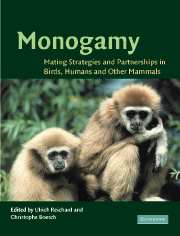Book contents
- Frontmatter
- Contents
- List of contributors
- Acknowledgements
- Introduction
- PART I Evolution of social monogamy
- CHAPTER 2 The evolution of monogamy: mating relationships, parental care and sexual selection
- CHAPTER 3 Mate guarding and the evolution of social monogamy in mammals
- CHAPTER 4 The evolution of social monogamy in primates
- CHAPTER 5 The evolution of social and reproductive monogamy in Peromyscus: evidence from Peromyscus californicus (the California mouse)
- PART II Reproductive strategies of socially monogamous males and females
- PART III Reproductive strategies of human and non-human primates
- Index
CHAPTER 2 - The evolution of monogamy: mating relationships, parental care and sexual selection
Published online by Cambridge University Press: 05 July 2014
- Frontmatter
- Contents
- List of contributors
- Acknowledgements
- Introduction
- PART I Evolution of social monogamy
- CHAPTER 2 The evolution of monogamy: mating relationships, parental care and sexual selection
- CHAPTER 3 Mate guarding and the evolution of social monogamy in mammals
- CHAPTER 4 The evolution of social monogamy in primates
- CHAPTER 5 The evolution of social and reproductive monogamy in Peromyscus: evidence from Peromyscus californicus (the California mouse)
- PART II Reproductive strategies of socially monogamous males and females
- PART III Reproductive strategies of human and non-human primates
- Index
Summary
INTRODUCTION
Monogamy is defined as a unique social relationship between one adult female and one adult male for the purpose of reproduction. Monogamy is a mating system particularly common in birds, but also occurring infrequently in invertebrates, fish, amphibians, reptiles, and mammals. Polygyny or promiscuous mating systems appear to be predominant in animals. Why should that be the case? And why is monogamy so rare?
Using birds as a model system, in this chapter I explore a number of different selection pressures that may shape monogamy. The reason for restricting the analyses to birds is that comparative data of a similar extent are simply unavailable for any other class of animals. However, whenever possible, I refer to other taxa (i.e., when data are available).
While the close spatial co-occurrence of a single male and a single female during an extended period of time is the pre-eminent criterion for defining monogamy, a number of other features characterize some, but not necessarily all, monogamous mating systems: (i) a social relationship between a male and a female; (ii) male provisioning of parental care; and (iii) a reduced sexual dimorphism compared with polygynous mating systems. The second feature involves parental investment by an adult male in offspring at the expense of mating effort, suggesting that male care, as opposed to pursuit of additional females, is a superior way of creating fitness returns.
- Type
- Chapter
- Information
- MonogamyMating Strategies and Partnerships in Birds, Humans and Other Mammals, pp. 29 - 41Publisher: Cambridge University PressPrint publication year: 2003
- 25
- Cited by



